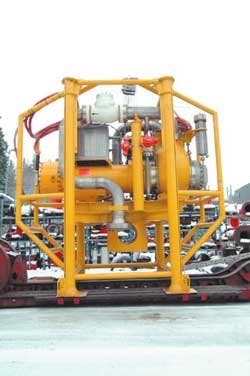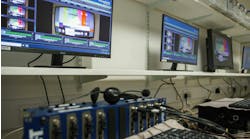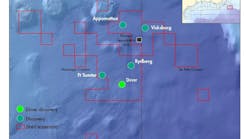Kværner Eureka has launched a subsea multiphase pump module called the Subsea MultiBooster. By enabling the wellstream to be transported over long distances, the MultiBooster closes an important technology gap, says Per Sørum, area sales manager for subsea rotating equipment in Kværner Eureka's oil and gas division.
Early this year the MultiBooster successfully completed testing at Statoil's Kårstø Metering and Technology Laboratory (K-Lab) at Kårstø in western Norway. "This is the first twin-screw pump which has finished hydrocarbon testing and is commercially available," Sørum said. "It's ready for subsea installation."
For Kværner the launch marks the culmination of the best part of 20 years of research and development. A series of studies in the mid to late 1980s led on to the Kværner Booster Station (KBS) project between 1989 and 1994. The KBS performed both separation and boosting, and won the ONS Innovation Award in 1992. However, though it met an acknowledged offshore need, it appeared to have hit the market before the market was ready, thus it found no takers.
Using largely the same personnel, and with a solid jumping-off point in the KBS technology, Kværner has since been refining its subsea pumping technology, and is now close to completing the development of three subsea boosting products: the Subsea MultiBooster; the Subsea LiquidBooster, a subsea single-phase centrifugal pump; and the Subsea GasBooster, a subsea gas compression module.
In the last couple of years the technology development has taken place in close proximity to potential customers. Both the Subsea MultiBooster and the Subsea Gas Booster have become part of the Demo 2000 program initiated by the Norwegian government to demonstrate leading-edge technologies. Both projects are also sponsored by the Fram and Gjøa licenses, which are operated by Norsk Hydro with ExxonMobil, RWE-DEA, Shell, and Statoil as partners.
Kværner Eureka and Hydro jointly established the design basis for the MultiBooster, using wellstream data from the Sognefjord reservoir in the Fram Field. The development scenario was to boost the wellstream from this reservoir so that production could be commingled with that from other reservoirs with higher pressures.
On the equipment side, Kværner Eureka made a careful choice of partners with well-proven technologies:
• Bornemann Pumps of Germany: twin-screw pump
• Flender Loher of Germany: oil-filled electric motor
• Connecteurs Electriques Deutsch of France: high-voltage penetrators.
The twin-screw pump and other components represent proven technology. The challenge was putting them to work on the seabed. Kværner Eureka itself provided the subsea expertise, putting together the pump and marinizing it. "It's all about sealing, cooling the motor, lubrication challenges, and pressure balancing," Sørum said.
The footprint of the prototype unit, tested at K-Lab, is 5.5-m long by 2.5-m wide by 5.5-m high and its weight is 43 tonnes. It is mounted on a skid, but could equally well be integrated with other subsea equipment. The present unit, which has capacity to pump 940 cubic meters/hour, has proved to be applicable to various other developments and can be regarded as a medium size MultiBooster. It is designed for 1,500-m water depth and installation by guideline, but the design criteria could easily be extended to 3,000-m depth and guidelineless installation, Sørum said.
The MultiBooster underwent testing using water at Kværner Eureka's production facility outside Oslo in November 2001. Its performance was satisfactory and in line with expectation. Early this year it moved onto demonstration trials using real hydrocarbons at the K-Lab, which provides an environment close to real subsea conditions. Here it was submerged in a 12-m high water tank and connected to a hydrocarbon "reservoir" allowing circulation of oil, gas, and water. The gas content could be adjusted by varying the gas volume fraction (GVF) from 0 to 100%.
The program was divided into four parts designed to test the MultiBooster's efficiency both as a multiphase pump and wet gas compressor. These were multiphase performance test with efficiency measurements, wet gas performance test with efficiency measurements, liquid slug performance test, and vibration tests.
The same test procedure is used for both the multiphase and wet gas performance tests, the distinguishing criterion being that a wellstream with a GVF of 98% or more is defined as dry gas.
The test matrix included running speeds from 500 to 2,000 rpm, at steps of 200-300 rpm, differential pressures from five to 40 bar, in steps of five bar, three inlet pressures – one, 25, and 40 bar, and GVFs of 0, 25%, 50%, 60%, 75%, 98%, and 100%. Liquid slugs were also introduced into the wellstream to test the pump's capabilities. This was performed at various speeds and pressures.
All the tests have been performed successfully and a complete test report will be issued in April or May, Sørum said.
He sees two main scenarios in which the pump provides benefits. First it can boost pressure in low-pressure subsea wells and during tail-end production. It also can enable development of marginal fields, which would not be economic using traditional technology.
Applying MultiBooster technology to low-pressure wells boosts the wellstream, resulting in a pressure increase, which relieves the backpressure in the well that holds back the flow. In the case of a low-pressured reservoir, it could be used from start-up or introduced as pressure falls away in the course of the field's production life. By enhancing production, it enables reserves from a field to be produced over a shorter period, thus reducing operating costs. It may also increase the volume of reserves that can be recovered.
The technology also enables the wellstream to be transported over much longer distances than it can travel naturally – up to 100 km, according to Sørum. This greatly extends the tieback radius, and offers a subsea development option for fields that would otherwise require on-site separation or other forms of processing. The technology opens up the possibility of tying many more fields directly back to shore, and makes it possible to consider for development fields which would otherwise be assessed as uncommercial.
The Demo 2000 MultiBooster has a 1.6 MW motor, sufficient to transport a multiphase stream 10 km. To achieve greater distances, a more powerful motor would be required – 2.5 MW seems to be the practical limit, Sørum said.
The Subsea LiquidBooster is already available for pumping single-phase liquid flows, while the development of the Subsea GasBooster is well advanced – design of the unit has been completed, and a prototype is due to be built and tested later this year.




